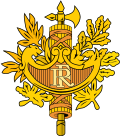
Back President van Frankryk Afrikaans President d'a Republica Francesa AN Franclandes Foresittend ANG رئيس فرنسا Arabic رئيس فرنسا ARZ Presidente de Francia AST Франсиялъул президент AV Fransa Prezidenti Azerbaijani Présidén Prancis BAN Прэзідэнт Францыі Byelorussian
| President of the French Republic | |
|---|---|
| Président de la République française | |
 | |
 | |
since 14 May 2017 | |
| Executive branch of the French Government | |
| Style |
|
| Status | |
| Member of | |
| Residence | Élysée Palace |
| Seat | Paris, France |
| Appointer | Popular vote |
| Term length | Five years, renewable once consecutively |
| Constituting instrument | Constitution of France (1958) |
| Inaugural holder | Louis-Napoléon Bonaparte |
| Formation |
|
| Deputy | President of the French Senate |
| Salary | €182,000 per annum[1] |
| Website | www |
| This article is part of a series on |
 |
|---|
|
|
The president of France, officially the president of the French Republic (French: Président de la République française), is the executive head of state of France, and the commander-in-chief of the French Armed Forces. As the presidency is the supreme magistracy of the country, the position is the highest office in France. The powers, functions and duties of prior presidential offices, in addition to their relation with the prime minister and government of France, have over time differed with the various constitutional documents since the Second Republic.
The president of the French Republic is the ex officio co-prince of Andorra, grand master of the Legion of Honour and of the National Order of Merit. The officeholder is also honorary proto-canon of the Archbasilica of Saint John Lateran in Rome, although some have rejected the title in the past.
The current president is Emmanuel Macron, who succeeded François Hollande on 14 May 2017 following the 2017 presidential election, and was inaugurated for a second term on 7 May 2022 following the 2022 presidential election.
- ^ Président de la République: 14 910 € bruts par mois, Le Journal Du Net
